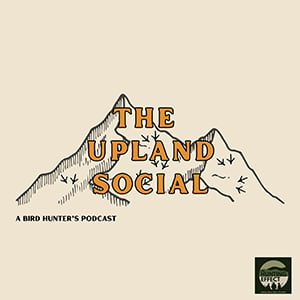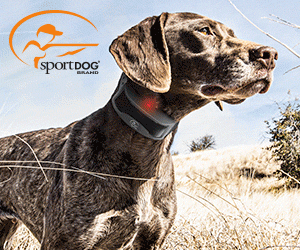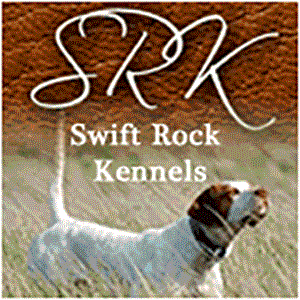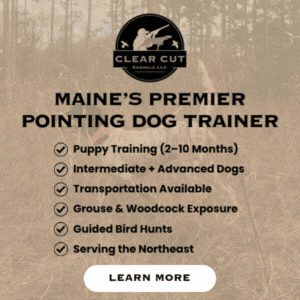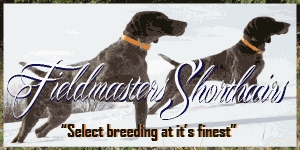Meet Gen Next

Jerry Kolter and his wife Betsy Danielson own Northwoods Bird Dogs in Sandstone, Minnesota. Their focus has been on English setters and pointers, with Labrador retrievers as personal dogs. Betsy has focused on puppy development for nearly her entire career and says, “A proper introduction of a puppy to an adult dog really begins with the breeder. Everything is new for a puppy, and if they have confidence that comes from positive interactions with people, their living environment, and the outside world then they’ll more easily adjust to new things. Puppies that are confident and relaxed interact more peacefully with adult dogs.”
It helps new owners to learn how their breeder has acclimated the litter of puppies. “Jerry and I created our Super Puppy Program many years ago,” Betsy said. “Jerry begins working with puppies on Day 3 and continues through week 4. I take over at that point and work with the litter until they are picked up at around 8 weeks. We use a variety of benchmarks first to stimulate the pup’s learning and then to build a foundation. To get them used to human contact I’ll handle them constantly and touch them on their back, under their belly, and basically all over. To get them used to dealing with change I’ll turn puppies around in different directions. I’ll run cold cotton swabs through their paw pads which comes in handy later on if an owner needs to remove Hawthorne tines or to cut their nails. By week 4 I leave the whelping box door open so the pups can check things out and knock around with their litter mates. By the time the pups are 8 weeks old they are bold, confident and relaxed. That attitude helps them remain calm when they meet new people, animals, and dogs.”

When the time comes to introduce puppies to older dogs, Danielson follows an orchestrated introduction. “When the new owners come to pick up their puppy I ask them to bring along their adult dogs,” she said. “I’ve found these introductions to be more successful if they’re conducted in an area that is familiar to a puppy. Puppies are less likely to get overwhelmed, stressed, or ramped up if they are in a familiar area. I like that first contact to be in an outside area, too. Leash both the adult dog and the puppy and keep them under control. I let the puppy walk around the older dog and check him out. Puppies are curious and have lots of energy. If they get excited then their behavior can get animated. Many older dogs don’t like that type of unbridled energy, and if your puppy gets ramped up then walk him away until he relaxes. Then, begin again.”
Positive first introductions are critical. “It only takes one bad experience to ruin a puppy,” Danielson said. “If that first experience is scary or traumatic for the puppy then it’s going to take a lot of work to overcome that hurdle.”

Danielson offers five other pointers to help make a solid introduction.
- Feeding should be separate until the puppy has matured in both size and attitude. “Things start to smooth out when the puppy reaches between four and five months of age. The puppy has grown taller, he’s put on weight, he has better motor coordination and has more experience in the world. Food can cause a lot of competition, so feed your puppy and adult separately. That’s especially important if one eats faster than the other.”
- Give them some room. “To stay relaxed, puppies and adults should stay separated for some part of the day. After they spend time together put them in different rooms to take a nap. That time apart helps them relax, too.”
- Go for a walk “Puppies and adults get better acquainted if you take them for a walk together. Puppies are intrigued by their new world, and that curiosity stimulates their minds. If they’re engaged, then they’re less likely to get bored and pick at an adult.”
- Let sleeping dogs lie. “Puppies sleep a lot, and when they wake up they want to play. Things can get out of control very quickly if a puppy bounces around older dogs, especially if the older dog is sleeping. Always keep the puppy and adult under supervision until they’ve proven they’re capable of getting along.”
- Growling? It depends. “Not all growling is bad. Some of it is an adult dog setting a boundary. Most owners recognize the bad kind of growling which is usually a low tone that rises up into an aggressive series of barks. Read each situation and separate the puppy if he’s not getting the message that he’s overstepping his boundaries.”

Chris Akin of Webb Footed Kennels in Jonesboro, Arkansas, is constantly introducing Labrador retriever puppies to adult dogs. Akin, a Eukanuba pro trainer, spends a lot of time with the adult dog and the puppy prior to an introduction so he clearly and fully understands the demeanor and attitude of each.
“Some adult dogs are tolerant and patient with highly active puppies, while others simply don’t like ‘em at all,” he said. “Properly introducing the two is important for everyone’s safety, so take it slowly and progressively. Puppies have sharp teeth and want to play constantly. An older, chill dog may not appreciate a puppy yanking on his ears or pouncing on him while he’s asleep. An older dog is a lot bigger than your pup and can retaliate with aggression.
“These introductions take time, and I like them to be short in time and regular in frequency. Supervision is important, so start by holding your pup instead of letting him run around. Talk calmly to both dogs and let them sniff each other out before releasing your pup to the ground. If stress or tension comes from the adult dog, then separate the two and begin again.”

Akin calls out a few situations that require additional focus.
- The chill zone. “Settings for introductions between puppies and adults always should be relaxed and calm. If you’re trying to make an introduction between the two and there are a lot of distractions, then both adult and pup can get ramped up. Maybe it’s simple stuff like your kids coming home from school or heading out for football practice. Maybe it’s dinner time and there’s a lot of commotion and banging of plates, pots and pans. It’s the digital age so phones ringing or pinging adds to the commotion, all of which can cause dogs to get stressed out. To keep those introductions from getting heated make sure they’re made when the external noise is low.”
- Dominance. “Dominant adult dogs and puppies usually don’t mix. The dominant dog, be it a male or a female, is laying claim to being the top dog. At his young age, puppies want to play and have fun. It’s really easy for an adult dog to perceive that attitude as challenging and aggressive when it’s not. I’ve got a lot of dogs at the kennel, so when it comes to introductions, I’ll make sure the adult isn’t dominant.”
- Possession is 9/10ths of the law. “Animals are territorial, and that’s something to be aware of when introducing puppies to adults. If an adult has a favorite place to lay down or if he’s got a favorite bone to chew then make sure that the puppy doesn’t try and take it. The puppy might just be playing, and that’s fine, but let the puppy knock around with another puppy. The adult might get mad, and y’all don’t want that.”
When introduced correctly your puppy and adult dog will learn their boundaries. They’ll become part of the newly expanded pack, and they’ll all be a joy to be around. Take your time, don’t force the introduction, and make sure it’s good. The next decade depends on it.
Related Aritlces
Tick Check
When it comes to ticks, the only thing you need to know is that they should be avoided at all costs. Nothing good comes from an association with a tick. They’ll latch on to you, your dog, your wife and kids, your horses, and anything else they can sink their grubby meat hooks into. Diseased ticks can leave you sick for the rest of your life.
Read Your Dog
Just because a gun dog can’t speak doesn’t mean he’s not saying anything. Reading the dogs’ body language is key for elevating performance levels, so here are some things pro trainers look for when they cut loose their string.






